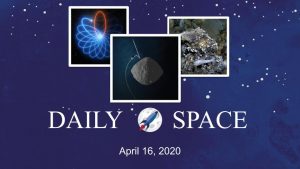
NASA’s first asteroid-sampling spacecraft is one step closer to touching down on asteroid Bennu. By mimicking rocky seafloor chimneys in the lab, scientists have produced new evidence that these features could have provided the right ingredients to kick-start life. A star orbiting the supermassive black hole at the center of the Milky Way moves just as predicted by Einstein’s general theory of relativity. And we have an interview with astronomer Riley Connors, talking about his team’s research into black holes bending light that we can detect as reflections of accretion disks
Links
NASA’s first asteroid-sampling spacecraft is one step closer to touching down on asteroid Bennu
- One step closer to touching asteroid Bennu (OSIRIS-REx)
- OSIRIS-REx spacecraft carries out first of two rehearsals before sampling asteroid (SpaceflightNow)
Scientists have produced new evidence that deep sea vents could have provided the right ingredients to kick-start life
Star orbiting the supermassive black hole at the center of the Milky Way moves just as predicted by Einstein’s general theory of relativity
Interview with astronomer Riley Connors, talking about his team’s research into black holes bending light that we can detect as reflections of accretion disks
- Black Hole Bends Light Back on Itself (CalTech)
- New black hole study proves a 40-year-old theory (SlashGear)
Transcript
This is the Daily Space for today, Thursday, April 16, 2020.
Welcome to the Daily Space, I am your host, Dr Pamela Gay, and I am here to put science in your brain. Most Mondays through Fridays either I or my co-host Annie Wilson will be here, bringing you a quick run down of all that is new in space and astronomy.
Today’s news is coming at us from all directions, as astronomers, planetary scientists, and astrobiologists all work to advance our exploration of the universe. As part of today’s news, we will be joined by astronomer Riley Connors who will be talking about his team’s research into black holes bending light that we can detect as reflections off accretion disks.
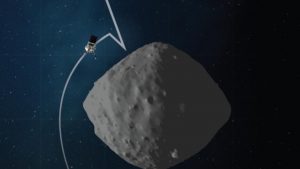
Our first story is one that is near and dear to us. The OSIRIS-REx mission has successfully completed a dress rehearsal of collecting a sample from the asteroid Bennu’s Nightingale crater. While they didn’t actually reach out and touch Bennu on this go around, the mission team did prove that the spacecraft can successfully deploy and retract its sample arm, and that it is capable of all the necessary orbital maneuvers to dive down to the surface and then return safely to a standard orbit. As part of the trial run, the mission team acquired amazing images of the asteroid’s surface that are key to verifying the space craft’s potential for successful sampling. They also took science data, including spectrometry to study the composition of rocks at this site.
During this rehearsal, the OSIRIS-REx mission travelled within 75 m or 246 ft of Bennu’s surface – this is the closest they’ve ever approached. For the next several months, the team will analyze all the data and telemetry from the mission as they prepare to make their first sample collection attempt on August 25. If everything goes as planned, OSIRIS-REx will return the sample home on September 24, 2023.
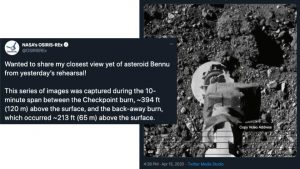
NASA and all international collaborators have plans in place to keep the sample sterile so that we humans can’t pollute it with our world’s bugs, and so whatever it brings home – if anything – can’t get out to us.
While it’s highly unlikely a smashed up asteroid like Bennu could be home to any form of life, there are plenty of other places in our solar system that seem like just maybe life could be possible.
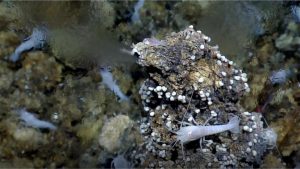
To understand where to look for life, we need to understand how life came to be on our own planet. Over the years, folks have debated where on Earth life might have started, and one of today’s dominant ideas has life starting at hydrothermal vents. In new research published in the journal Astrobiology, researchers in JPL’s Icy Worlds team have worked to simulate the conditions that might have existed at hydrothermal vents on Earth when our solar system was young and life was just starting. This was part of the graduate work of Lauren White, who brought together hydrogen-rich water such as flows out vents, seawater enriched with CO2, and the same mixture of minerals that were present in these regions. This was all done in a high pressure system that could simulate the moderate temperatures and high-pressures expected to have existed … and at a scale sufficient for them to observe how fluids flowed and mixed. This was a large lab experiment, the likes of which had never previously been done. But when you’re trying to simulate the formation of the chemistry required for life… sometimes it’s go big or learn nothing.
And this term learned something.
They found that the natural pulsations, pressures, and flows of hydrothermal vents are capable of forming the organic molecules formate and methane. This is just a first step in this research, but as now Dr White states, “I think it’s really significant that we showed that these reactions take place in the presence of those physical factors, like the pressure and the flow. We are still a long way from demonstrating that life could have formed in these environments. But if anyone ever wants to make that case, I think we’ll need to have demonstrated the feasibility of every step of the process; we can’t take anything for granted.”
If life can start at hydrothermal vents, this means our list of possibly habitable works includes a myriad of icy moons in our own solar system, and more worlds then we dare count that are out there orbiting alien stars.
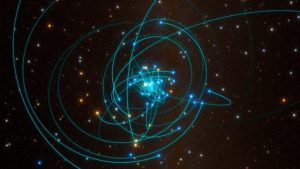
In our final story of the day, we have one more confirmation that the universe is well described by Einstein’s theory of relativity. For the past several decades, starting with Andrea Ghez, many astronomers have been using massive telescopes and special techniques to directly measure the orbits of stars around our galaxy’s supermassive black hole. Now, a team using ESO’s VLT has revealed that one of these stars is orbiting in a pattern that resembles a spirograph rosette pattern, rather than the mostly repeating ellipse we see with other objects. To be fair, all orbits are rotating a bit through a process called Apsidal Precession, but most orbits don’t require us to make relativistic corrections to Newton’s basic equations of motion for us to match simulation to reality. For the star S2 near our SMBH, relativity, however, is totally required. With 27 years of data on its 16 year orbit, it’s possible to use 330 measurements to track how its orbit changes cycle after cycle…. And… it’s behaving exactly as Einstein would have expected. This is just a nice result of a pretty orbit, that took more than a generation of astronomers, and billions of dollars of instrumentation. When it comes to the universe, sometimes the things that seem the easiest – measuring a star orbit – can be ridiculously hard. But… it sure is worth it when everything comes together in the end.
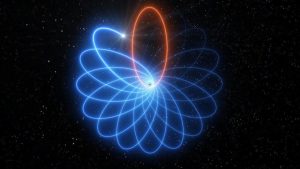
Studying the effects of relativity is one of those things that is often easier said than done. More than 100 years after his publications, we’re still working to observe in the universe everything Einstein predicted in his research. One of those predictions – that light can be bent to orbit black holes, was the research of today’s guest. In just a moment I will be joined by CalTech researcher Riley Connors. Don’t go anywhere. I’ll be right back and we’re going to be talking X-Ray photons and reflection off accretion disks.
<———————>
As part of helping keep us all occupied in these really weird times, we’re going to be hosting a lot of additional content on our Twitch channel, and we want to remind you that CosmoQuest has an active community on Discord where you can talk science, volunteer for various projects, and even find other people to join you in playing some online games. You can find links to everything that is going on at CosmoQuest.org.Thank you all for listening. Today’s script was written by Pamela Gay, and the Daily Space is produced by Susie Murph. The Daily Space is a product of the Planetary Science Institute, a 501(c)3 non profit dedicated to exploring our Solar System and beyond. We are here thanks to the generous contributions of people like you. The best way you can support us is through Patreon.com/cosmoquestx Like us? Please share us! You never know whose life you can change by adding a daily dose of science.


 We record most shows live, on Twitch. Follow us today to get alerts when we go live.
We record most shows live, on Twitch. Follow us today to get alerts when we go live.